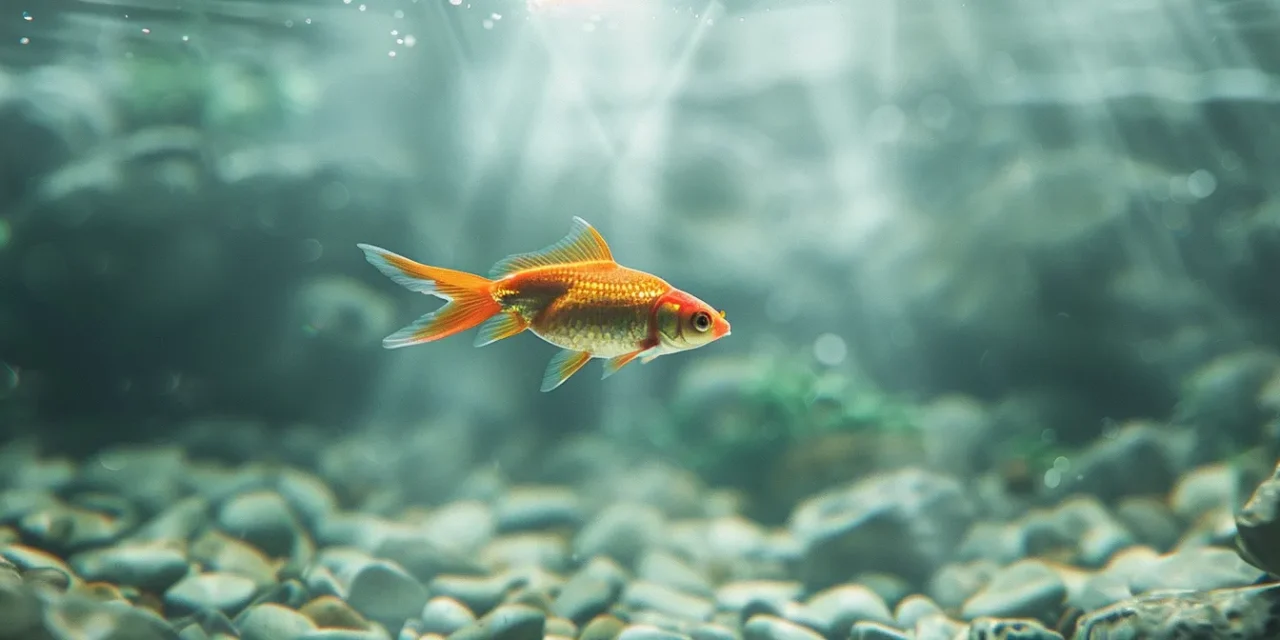Table of Contents
ToggleTable Of Contents:
- Surviving the Fast: Understanding Goldfish Food Requirements
- Unveiling the Mystery: How Long Can Goldfish Go Without Food
- Understanding Goldfish Fasting Basics
- Factors That Affect Fasting Duration in Goldfish
- Identifying Signs of Food Deprivation
- The Role of Water Temperature in Goldfish Fasting
- How Temperature Impacts Metabolism
- Optimal Temperature Ranges for Fasting Periods
- Adjusting Feeding Schedules According to Temperature
- Recognizing the Signs of Starvation in Goldfish
- Physical Indicators of Underfeeding
- Behavioral Changes During Starvation
- Long-Term Effects of Inadequate Feeding
- Guidelines for Safely Fasting Your Goldfish
- Preparing Your Goldfish for a Fast
- Determining Safe Fasting Durations
- Transitioning Back to Regular Feeding Routines
- Feeding Strategies to Optimize Health During Fasts
- Selecting the Right Food Before and After Fasts
- How Frequent Feedings Can Benefit Post-Fast Recovery
- Supplements and Vitamins to Support Health
- Debunking Myths About Goldfish and Fasting
- Addressing Common Misconceptions
- The Truth About Goldfish Memory and Fasting
- Scientific Evidence on Goldfish Fasting Needs
- Conclusion
Surviving the Fast: Understanding Goldfish Food Requirements
Goldfish are hardy creatures, often surprising owners with their resilience to varying conditions in an aquarium. However, their robustness doesn’t free us from the responsibility of understanding their dietary needs. Unsuitable care, including improper feeding practices and the use of untreated tap water, can lead to stunted growth and erratic behavior, indicating compromised health. In this article, you’ll unlock essential insights into the fasting requirements of goldfish, dispelling widely-held myths and paving the way for a thriving aquatic environment. Keep reading to ensure your finned friends receive the best care during their fasting periods.
Unveiling the Mystery: How Long Can Goldfish Go Without Food

Marveling at the resilience of goldfish, one begins to question the extent of their fasting endurance—an essential consideration to prevent stress and maintain their health. Indeed, understanding the basics behind their fasting needs opens a gateway to better care, where the risk of obesity looms as a genuine concern due to overfeeding. Much like tropical fish that have specific dietary patterns, goldfish are often subject to similar scrutiny. My investigations into their fasting capacities reveal that several factors, such as water temperature, filtration efficiency, and the overall health of the pet, play a pivotal role in determining the safe duration they can go without food. With health being paramount, it is vital to identify early signs of food deprivation that could lead to unwarranted stress or illness within these aquatic pets. A balanced approach is therefore not just recommended; it is crucial for the wellbeing of your aquatic companion.
Understanding Goldfish Fasting Basics
Embarking on the journey to comprehend the dietary breaks for goldfish, it becomes clear that much like meal timing for humans, these aquatic creatures display variable tolerance to periods without eating. While goldfish are opportunistic and will often indulge in a worm or mosquito larva whenever possible, their metabolism adapts to the environment inside the tank. My current understanding is that it’s less about if they can go without food, and more about how their bodies cope with the absence of regular meals, which requires a nuanced approach tailored to their habitat conditions.
Factors That Affect Fasting Duration in Goldfish
Goldfish survival during periods of fasting hinges on several variables, with body fat reserves and overall health being definitive factors. The longer a goldfish can sustain itself without food typically relies on the amount of fat it has stored; well-nourished goldfish can generally last longer. Conversely, a fish that is already stressed or in poor health may not fare as well without regular feedings.
Their natural environment plays a substantial role as well; a goldfish in a well-maintained aquarium, complete with an efficient aquarium filter and a stable ecosystem similar to a tetra habitat, may experience less stress and have a higher fasting tolerance. This insight leads us to ask: how long can goldfish go without food? The answer varies but under optimal conditions, a healthy goldfish can survive for one to two weeks, albeit not without potential risks:
- Diminished fat reserves could compromise immune function.
- An imbalance in the aquarium‘s ecosystem may emerge without the routine of regular feeding.
- Stress levels in goldfish might rise, heightening susceptibility to sickness.
Identifying Signs of Food Deprivation
Monitoring your goldfish for signs of nutritional deficiency is essential; if I notice my animal exhibiting a dulled color, listlessness, or a gaunt appearance, these could be indicators of inadequate food intake or potential disease. I always recommend fellow enthusiasts join a mailing list dedicated to fish care or consult a knowledgeable pet store associate to stay informed about the subtleties of goldfish health and their dietary needs.
Discovering the endurance of goldfish during periods without food reveals their remarkable resilience. Now, let’s turn our attention to the crucial factor of water temperature and its impact on goldfish fasting.
The Role of Water Temperature in Goldfish Fasting

Temperature significantly affects the metabolic rate of goldfish, which in turn influences their dietary needs during fasting periods. It’s crucial to understand how their bodies respond to the water temperature in their tank. For instance, higher temperatures accelerate metabolism, prompting an increase in food consumption to maintain energy, while cooler temperatures tend to slow down their digestive process, reducing the need for frequent feedings. The calibration of their feeding schedule thus becomes pivotal; a careful balance that respects the temperature range that aligns with their biological functioning. The optimal temperature range for goldfish to endure fasting extends from the mid-60s to the mid-70s in Fahrenheit. Within this bracket, the breakdown of ammonia, a byproduct of waste, is efficiently processed by bacteria in the substrate, while nutrients from occasional feedings – from shrimp to vegetable options – are optimally utilized. As a practitioner of aquatic pet care, I monitor and adapt the length and frequency of feeding sessions to harmonize with these temperature fluctuations, ensuring my goldfish flourish even when their meals are less frequent.
How Temperature Impacts Metabolism
In the dynamic ecosystem of a goldfish‘s tank, water temperature serves as a pivotal influencer on metabolic rate, directly impacting how they process their diet and utilize energy. A warmer aquatic habitat can cause a spike in metabolic activity, leading fish to require more frequent feedings to maintain their buoyancy and vitality. Conversely, a drop in temperature puts their systems into a slower state, where less energy is expended and the efficiency of digesting both plant and animal matter increases, reducing the need for constant nourishment.
Optimal Temperature Ranges for Fasting Periods
During a fasting period, especially if a goldfish owner is planning a vacation, maintaining the temperature range between 68 to 74 degrees Fahrenheit is essential. At this range, the swim bladder functions optimally, reducing the risk of floatation issues which can be exacerbated by overfeeding or poor diet. Furthermore, with a stable temperature, the tank‘s ecosystem maintains lower levels of nitrite, preventing additional stress that could lead to health problems for goldfish who opportunistically graze on available insect larvae or other food sources.
Adjusting Feeding Schedules According to Temperature
In response to the shifting temperatures within my goldfish tank, I’ve learned the importance of modifying their feeding schedules accordingly. When the water warms, I sometimes enrich their diet with high-protein options that cater to their heightened energy demands; but as temperatures drop, I reduce the feedings, knowing their metabolism has slowed and their stomachs require less frequent nourishment. This careful adjustment helps maintain their fin health and reduces the risk of bacterial overgrowth, ensuring no excess waste compromises their environment and no medication is needed due to improperly managed feeding practices.
Understanding how water temperature impacts goldfish eating habits sets the stage for our next critical topic. Let’s now turn our attention to recognizing the signs of starvation in goldfish, ensuring their health and longevity.
Recognizing the Signs of Starvation in Goldfish

Accurately gauging the food requirements for goldfish is critical in fishkeeping to avoid the severe consequences of starvation. In my meticulous observation of these graceful swimmers, I’ve come to recognize the crucial signs that indicate a lack of nutrition. Physical indicators such as a sunken belly or visible backbone can alarmingly signal the crucial need for intervention. On the behavioral front, a marked change in activity, like lethargy or erratic swimming, often accompanies prolonged fasting. Over time, insufficient feeding not only affects the fish‘s bladder control but can also induce serious health issues, disrupting the delicate balance of their pond or aquarium. As algae serves as a natural food source in their habitat, a goldfish foraging more frequently might imply it’s not receiving adequate sustenance. Monitoring the pond species for these symptoms forms an essential part of responsible fishkeeping, proving that sustaining these creatures goes far beyond simply doling out flakes or pellets—it encapsulates an understanding of their biology and dietary needs.
Physical Indicators of Underfeeding
In tracking the wellbeing of my goldfish, weight loss manifests as a principal indicator of underfeeding, a condition that must be rectified promptly to prevent a downturn in their metabolism and overall health. The absence of a rounded belly and a more pronounced backbone immediately set off alarms for me, signaling a critical deficiency in nutrient intake. For quick advice, I find it invaluable to share observations and concerns via email address with fellow enthusiasts or experts, who can provide guidance to reverse the negative effects of inadequate feeding.
Behavioral Changes During Starvation
During periods of fasting, behavioral shifts in goldfish provide telltale signs of malnutrition; lethargy or a decrease in their usual playful interaction often becomes evident. A fish pond‘s energetic environment might change to one of inactivity, and your goldfish may forgo their usual scramble towards dog food or brine shrimp during feeding times. Recognizing these changes is vital for intervening before the fasting leads to health deterioration:
- Observe decreased energy levels and interaction with other fish.
- Watch for lowered interest when favorite foods like dog food or brine shrimp are introduced.
- Consider fasting impacts and act swiftly to readjust feeding regimens.
Long-Term Effects of Inadequate Feeding
Persistent underfeeding in goldfish can precipitate a series of health issues which, over time, might compromise not only their vitality but the equilibrium of the aquatic habitat itself. Decreased immunity from ongoing malnutrition leaves these fish vulnerable to diseases, including those that could spread to tank mates like the robust koi or delicate guppy. In my experience, maintaining optimal water quality, with attention to maintaining the right pH balance, is especially critical for undernourished goldfish, as their weakened state demands a pristine environment to stave off further stress and potential health decline.
Having uncovered the worrisome signals of a malnourished goldfish, it’s time to pivot our attention to a healthier aquatic regimen. Let’s guide you through the safe practices of fasting your goldfish, ensuring their well-being and longevity.
Guidelines for Safely Fasting Your Goldfish

Ensuring my goldfish‘s well-being during a period without food is not about improvisation; it’s rooted in careful planning and understanding. When contemplating a fast—perhaps when I’m visiting the tulip fields of the Netherlands or simply leading a busy life—preparing these aquatic friends in advance is critical. Safeguarding their health involves assessing their current diet and condition, setting a clear and safe timeline for the fast, and ensuring a smooth transition back to their standard feeding routines. These steps are designed to minimize the stress on the fish and the risk of potential health complications. Planning for a fasting period also means acknowledging the unique needs of each individual goldfish, something I have learned is as important as providing the right water conditions or tank companions.
Preparing Your Goldfish for a Fast
Before initiating a fast for your goldfish, it’s imperative to ensure they are starting from a robust state of health: this begins with a period of balanced nutrition. Ensuring their diet includes a diverse mix of proteins and vegetables contributes to building their reserves, which is critical before they face a spell without their usual feedings:
- Evaluate the goldfish‘s overall health and vitality.
- Strengthen their dietary routine with varied and nutritious meals.
- Increase their reserves in preparation for the fasting period.
The transition into the fast should be gradual, not abrupt, adapting their feeding schedule down in a stepwise fashion to help their metabolism adjust without unnecessary stress. This approach helps preserve their vitality and prepares them efficiently for the forthcoming dietary pause.
Determining Safe Fasting Durations
Establishing the correct duration for fasting your goldfish requires a careful examination of their environment and health: seasoned fishkeepers agree a healthy goldfish in a well-maintained tank can fast for a week or two. However, to determine the safest fasting time for your specific goldfish, consider factors such as age, health, and prior dietary habits. Ensuring a reliable baseline of their typical behavior and health before beginning the fast helps in setting that optimal timeframe.
- Examine the age and health status of each goldfish.
- Assess their typical dietary patterns and feeding frequency.
- Establish a safe fasting duration based on gathered insights.
Transitioning Back to Regular Feeding Routines
Upon my return to the regular schedule, I gently reintroduce food to my goldfish, starting with small, easily digestible meals to allow their metabolism to readjust. This can take several days, but patience is key to avoid digestive issues or shock to their system, which can be detrimental after a period of fasting. Care is taken to monitor their response and health, gradually increasing portions to their normal size as they reacclimate to their routine feeding regimen.
Now that you’ve learned the foundations of safe fasting for your goldfish, let’s shift focus to the equally critical aspect of nutrition. Meet the feeding strategies that promise to enhance your goldfish‘s health throughout fasting periods.
Feeding Strategies to Optimize Health During Fasts

In my careful management of goldfish care, the approach to feeding during and following fasting periods proves critical for their health. My strategy revolves around selecting the appropriate food that ensures their dietary needs are met with precision. Preparing for a fasting period involves careful consideration of what to feed my goldfish to bolster their health. At the same time, post-fast feeding requires a thoughtful return to routine that encourages recovery and minimizes stress. Furthermore, I look into incorporating suitable supplements and vitamins into their diet to enhance their vitality and resistance against potential health challenges. In focusing on these aspects, I aim to provide a seamless transition for my goldfish, retaining their well-being throughout the entire fasting phase.
Selecting the Right Food Before and After Fasts
As an experienced aquarist, selecting the proper nutrition for my goldfish before and after a fast is paramount to their health. Prior to fasting, I focus on providing a varied diet rich in essential nutrients that build up their energy reserves; this typically includes a combination of high-quality pellets, brine shrimp, and leafy greens. Then, when reintroducing food post-fast, I opt for easily digestible options such as cooked peas without their shells, to ensure a gradual and safe return to their normal dietary patterns.
How Frequent Feedings Can Benefit Post-Fast Recovery
Guiding my goldfish back to their usual vitality post-fast involves meticulous feeding intervals. Smaller, more frequent meals aid their digestive systems in regaining strength without overwhelming them: an approach nurturing their gradual return to full health.
- Initiate the post-fast feeding with small portions to avoid digestive stress.
- Gradually increase the meal sizes as the goldfish‘s normal activity levels resume.
- Monitor their health closely to ensure they are benefiting from the feeding strategy.
Supplements and Vitamins to Support Health
Integrating supplements and vitamins into the diet of my goldfish has become a cornerstone of their health regimen, particularly during and after fasting periods. By providing a specialized blend of nutrients, I can enhance their immune system and fortify their resilience against stress and potential illness, especially when their regular feeding schedules are interrupted.
Let’s pivot our attention from human health to the aquatic realm with a fascinating angle. Next, we’ll sift through the murky waters of misconception to reveal the truth about goldfish fasting.
Debunking Myths About Goldfish and Fasting

Addressing misconceptions is an integral aspect of any informed discussion, and when it comes to goldfish, there are plenty to unravel. One prevailing myth questions their memory in the context of fasting, suggesting that their short-term recall is so limited that they will not remember whether or not they have been fed. My aim here is not only to clarify these inaccuracies but also to examine what scientific evidence has to say about the food requirements of goldfish during fasting. Exploring these misconceptions and grounding our understanding in research not only gives us a clearer picture of their needs but also informs how we can care for these pets responsibly and with compassion.
Addressing Common Misconceptions
The belief that goldfish possess a three-second memory is a common fallacy that undermines the understanding of their dietary cycles, especially during fasting. In my experience with these creatures, such notions are dismissed by their demonstrated capacity to remember complex survival mechanisms, including recognition of feeding patterns, which clearly impacts their behavior during times without food. It’s my goal to elevate the conversation beyond these myths, recognizing that goldfish are capable of adaptation and memory, which informs their fasting resilience.
The Truth About Goldfish Memory and Fasting
Contrary to the pervasive myth that goldfish have a three-second memory, research shows they are quite capable of remembering past events, a fact that’s crucial when considering their feeding during fasts. My observations agree, demonstrating that goldfish can indeed recall when they were last fed, which helps them adapt their behavior to different feeding schedules, including during periods when food is scarce.
Scientific Evidence on Goldfish Fasting Needs
The integration of scientific study into our understanding of goldfish fasting requirements has significantly enhanced the way we approach their care. Current research highlights the remarkable endurance of goldfish in navigating periods without food, underscoring a biological adaptation that supports short fasting: crucial information for aquarists when planning feeding schedules.
- Evaluate the goldfish‘s health and body condition before planning a fast.
- Consider environmental factors such as tank temperature and water quality.
- Using scientific research, establish a fasting duration that avoids undue stress for the fish.
Conclusion
Goldfish are resilient creatures capable of surviving without food for one to two weeks under optimal conditions, highlighting the importance of understanding their fasting tolerance. Careful monitoring of physical and behavioral changes is necessary to prevent malnutrition and associated health risks during these fasting periods. Adjusting their feeding regimens in relation to temperature changes in their environment ensures their metabolic needs are met efficiently. Ultimately, responsible goldfish care during fasting hinges upon a balance of adequate preparation, knowledge of their dietary needs, and the ability to recognize and address signs of stress and starvation.





